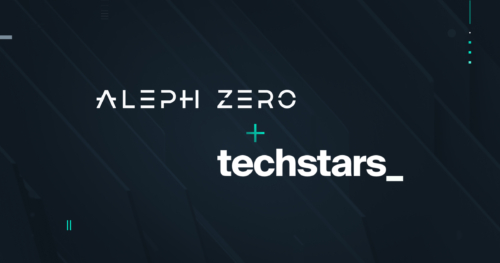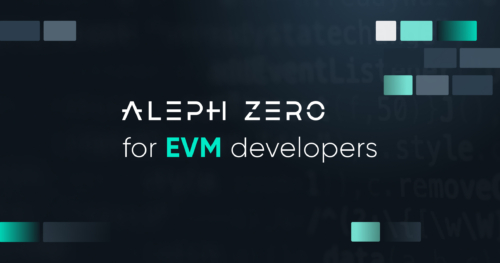This is Why We’re Building on Substrate
Apr 16, 2021

At the Aleph Zero Foundation, we’ve always believed in fundamentals. Back in 2018, we’ve literally heard that we’re somewhat crazy for developing a new layer one. “What’s wrong with X?”, we were asked. The answers were always the same: speed, scalability, decentralization. Especially in the Directed Acyclic Graph landscape.
A peer-reviewed DAG integrated with Substrate
Fast forward to 2019, and our novel consensus protocol—developed entirely in-house—has been peer-reviewed and presented at an Association for Computing Machinery (ACM) conference in Zurich. The event was sponsored by, among others, J.P. Morgan and Facebook, both of which are fairly active in the blockchain space. Our amazing team consisting of Adam Gagol, Michal Swietek, Damian Straszak, and Damian Lesniak did an incredible job not only with their invention; but also with how they told the story.
That set us on a path that we’ve always wanted to embark upon: to create a public blockchain that the people can trust thanks to formal security proofs. Bear in mind, though, that we’re not naive. We understand that a scientific paper and a real-world implementation are two different things. We’re aware that we were about to tackle an entirely new challenge—one that required not only brilliant mathematical minds but also outstanding engineering skills.
Python was our first pick. The Proof-of-Concept had been developed fairly quickly, and the test results were more than satisfactory. We knew that once we’ll deploy a production-ready Golang code, it’ll become even faster. We were estimating around 50,000-70,000 transactions per second. We’ve got 80,000-100,000 out of the Go implementation, with a 1-2 second confirmation time in an environment consisting of 112 nodes. And if I recall correctly, we’ve had a celebratory drink (okay, several celebratory drinks) the night the test results were in.
Fast forward to 2020, and we’re right in the middle of the bear market. We keep building; it’s not easy. So far, we’ve mainly relied on bootstrapping and the support of friends and family. The team is going through a series of challenges from both mental and physical perspectives. Lockdown doesn’t help; some agreements we’ve worked on for months fall apart because of the pandemic, and we’re definitely not prepared for that being a fairly young organization.
Still, we wanted to see the project through. We were exhausted, but hopeful. We knew we had something: we just weren’t sure how should we position it in this ever-evolving landscape.
“Cardinal Cryptography received the Web3 grant.”
That sentence changed a lot. Aleph Zero is being built by the team at Cardinal Cryptography, which you can think of as a very small equivalent of IOHK in the Cardano ecosystem, or an even smaller equivalent of Consensys in the Ethereum world.
For us, having received an external validation of this magnitude, it was “go” time. The team at Cardinal found the Web3 Foundation’s recognition exactly the type of confidence boost they needed. We’ve also had the opportunity to finally properly familiarize ourselves with Substrate while developing the randomness beacon. It wasn’t long before we decided it’s time to pivot.
“We should just use Substrate; there’s no point in reinventing the wheel”, said Michal, our CPO. All the chain management, networking, transactions processing—everything can simply be ported from the Parity’s stack. We’ve felt we’re very well-positioned to make the decision as we already were contributing to this incredible developer hub. And so, we’ve reimplemented our consensus in Rust for compatibility’s sake.
After all, we set out to innovate. We don’t need to rewrite something that is has already been developed by Parity for years. We just have to learn how to integrate the bits and pieces together, and take part in building the foundation of the new Internet.
We knew that the AlephBFT consensus will be more “performant” (yes, turns out it’s not a real word) than BABE and GRANDPA. At the same time, we knew we won’t be characterized as a parachain, because:
“Parachain consensus” is special in that it will follow the Polkadot Relay Chain. Parachains cannot use other consensus algorithms that provide their own finality. Only sovereign chains (that must bridge to the Relay Chain via a parachain) can control their own consensus. Parachains have control over how blocks are authored and by whom.
And we definitely want to use our consensus. That’s how you get the best out of both worlds. That’s how, finally, you create a public blockchain that even enterprises can trust.
Fortunately, we can still be a part of the Polkadot ecosystem and might decide to opt for a dedicated parachain bridge. Subtleties aside, this design allows to become deeply rooted within the Substrate community but still maintaining a sovereign chain with our high-throughput, bespoke protocol.
Stop reinventing. Innovate
Substrate is flexible, modular, and extensible. It takes care of all those daunting tasks so that we can focus on bringing more innovations—like the AlephBFT or our work on privacy in the form of tECDSA—to the space. Parity’s framework is by far the favorite of our R&D team; it’s battle-tested not only by Polkadot but also by a variety of different projects that aim to become parachains: Acala, Plasm, Edgware, Moonbeam, Darwinia. And that’s just the beginning.
We believe there’s no point to further divide the crypto landscape. We don’t need chains that are disconnected from the rest. We need to create the ultimate infrastructure layer that will help to connect, integrate, and enrich the ecosystem.

